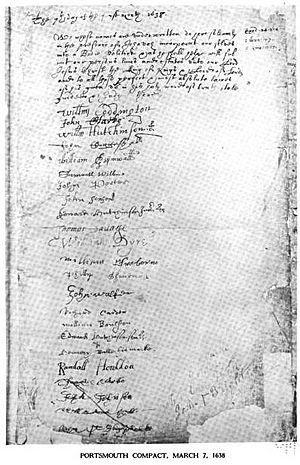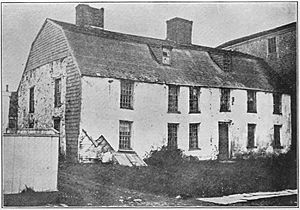Henry Bull (governor) facts for kids
Quick facts for kids
Henry Bull
|
|
|---|---|
| 12th and 14th Governor of the Colony of Rhode Island and Providence Plantations | |
| In office 1685–1686 |
|
| Preceded by | William Coddington, Jr. |
| Succeeded by | Walter Clarke |
| In office 1690–1690 |
|
| Preceded by | Edmund Andros under Dominion of New England |
| Succeeded by | John Easton |
| Personal details | |
| Born | 1610 |
| Died | 22 January 1693/4 Newport, Rhode Island |
| Resting place | Coddington Cemetery, Newport |
| Spouses | (1) Elizabeth _______ (2) Esther Allen (3) Ann (Clayton) Easton |
| Children | Jireh, Amy |
| Occupation | Corporal, Sergeant, Deputy, Assistant, Governor |
Henry Bull (1610–1694) was an important early leader in the Rhode Island Colony. He served as Governor of Rhode Island two times. His first term was before a period when England took more control of the colonies. His second term was after that period.
Henry Bull sailed from England when he was a young man. He first lived in Roxbury in the Massachusetts Bay Colony. But he soon followed religious leaders like John Wheelwright and Anne Hutchinson. These leaders had different ideas about religion than the main church. Because of this, Henry Bull was removed from the Roxbury church.
He joined many other followers of Anne Hutchinson. They signed an agreement called the Portsmouth Compact. Then they settled on Aquidneck Island in Narragansett Bay. A year later, he and others followed William Coddington. They moved to the south end of the island. There, they started the town of Newport.
Contents
Henry Bull's Early Life and Journey
Henry Bull was born in 1610. When he was 25, he sailed from London on a ship called the James. He arrived in America in 1635. He first settled in Roxbury in the Massachusetts Bay Colony.
Facing Challenges in Massachusetts
In late 1635, Henry Bull became a member of the Roxbury Church. But he soon started to follow new religious ideas. These ideas were different from what the church taught. Because of this, he was "excommunicated." This means he was officially kicked out of the church.
On November 20, 1637, he was one of many men in Boston. They were disarmed because they supported John Wheelwright. Wheelwright was a minister with different religious views.
On March 7, 1638, while still in Boston, Henry Bull signed an agreement. This agreement was to form a Christian government. He was one of 23 men who signed the Portsmouth Compact. He used a mark for his signature because he could not write his name.
Five days later, he was allowed to leave Massachusetts. He left with William Coddington, John Coggeshall, and others. Roger Williams suggested they buy land from the Native Americans. This land was along the Narragansett Bay. They bought the land and settled on Aquidneck Island. They started a settlement called Pocasset. Later, this place was named Portsmouth.
Building a Life in Rhode Island
On June 27, 1638, Henry Bull attended a meeting in Pocasset. That year, he was chosen as a corporal for the local military group. The next winter, he became a sergeant. One of his jobs was to manage the prison. It was decided that the prison should be built near his house.
In April 1639, there were disagreements in the Pocasset government. A group of nine men, including Henry Bull, signed a new agreement. They moved to the south end of Aquidneck Island. There, they started the town of Newport. In this group, William Coddington was the "judge." The other eight men, including Bull, were called "elders."
Once in Newport, Henry Bull was elected Sergeant for two years (1640-1642). In 1641, he became a freeman. This meant he had full rights as a citizen. Henry Bull built a house in Newport. This house stood for almost 300 years. It was sadly destroyed in a fire in 1912.
Many years passed before Henry Bull appeared in public records again. In 1655, he became a Commissioner for two years. In 1663, he and his son Jireh sold land on Conanicut Island (now Jamestown, Rhode Island). They sold it to Caleb Carr.
Henry Bull became a member of the Religious Society of Friends. These people are better known as Quakers. In 1665, Quaker records show that his wife, Elizabeth, died. Soon after, Bull married his second wife, Esther Allen, in Sandwich, Massachusetts.
Leading the Colony
As he got older, Henry Bull became more active in serving the colony. In 1666, he was elected Deputy to the General Assembly for a year. He held this position again from 1672 to 1674. He was also a Deputy in 1680. In 1671, he served as a juryman. In 1674, he was chosen as an Assistant for a year.
First Term as Governor
When King Charles II died in England, James II became king. This brought big changes to the New England colonies. In May 1685, the current Governor, Coddington, was re-elected but refused to serve.
So, the 75-year-old Henry Bull was chosen as governor. People said he was "as fearless as he was honest." Walter Clarke was chosen as his deputy. During this time, the colony's freedoms were being threatened. England was looking into problems in Rhode Island and Connecticut.
In October 1685, Joseph Dudley was appointed to govern Massachusetts and other colonies. This was part of a plan to put all the New England colonies under one ruler.
The Dominion of New England
In May 1686, Walter Clarke was chosen governor. But he served only a few weeks. Then, the Dominion of New England was created. This meant the northern colonies were put under one royal governor, Edmund Andros. Andros ruled for almost three years.
In April 1689, news arrived that William III and Mary II had become the new rulers in England. Andros was arrested. Walter Clarke called for an election in Rhode Island in May 1689. But he refused to be governor because of the uncertain times. For ten months, Rhode Island had no official governor.
The General Assembly met in October, but few people came because of a storm. They met again in February 1690. Walter Clarke again refused to be governor. Christopher Almy was elected but also said no. Then, people looked to Henry Bull. He was over 80 years old. This brave Quaker helped bring back Rhode Island's original government.
Second Term as Governor
At the Assembly meeting in May 1690, Henry Bull was again elected governor. But this time, the elderly leader declined the position. John Easton, the son of a former governor, became governor instead. He served for the next five years.
Henry Bull lived a long life. In the winter of 1693-1694, Quaker records noted his passing. "Henry Bull, aged about eighty-four years; he departed this life at his own house in Newport (he being the last man of the first settlers of this Rhode Island) ye 22d 11mo 1693-4 [January 22, 1694]." He is buried in the Coddington Cemetery in Newport. Other Quaker governors like William Coddington, William Coddington, Jr., Nicholas Easton, John Easton, and John Wanton are also buried there.
Family Connections
After his second wife died, Henry Bull married Ann Easton. She was the widow of former colonial Governor Nicholas Easton.
Henry Bull's grandson, Jireh (son of Jireh), married Godsgift Arnold. She was the daughter of Governor Benedict Arnold. His granddaughter Mary Bull and grandson Ephraim Bull both married grandchildren of early colonial President John Coggeshall. His grandson Henry Bull married a granddaughter of William and Anne Hutchinson. A distant relative of his is William T. Bull, who was a college football coach and a doctor.



